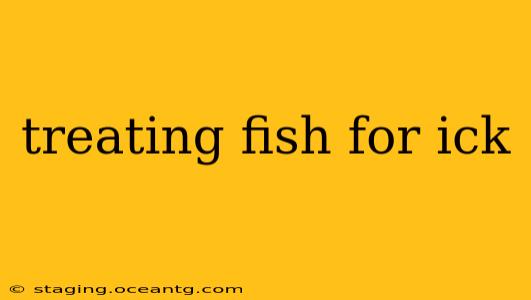Ich, also known as Ichthyophthirius multifiliis, is a common and highly contagious parasitic disease affecting freshwater fish. Recognized by its distinctive white spots on the fish's body, ich can rapidly weaken and even kill your fish if left untreated. This comprehensive guide will walk you through identifying ich, understanding its lifecycle, and effectively treating your infected fish.
What is Ich?
Ich is a microscopic parasite that attaches itself to the skin and gills of fish. These parasites reproduce asexually, resulting in a rapid multiplication and spread throughout the aquarium. The visible white spots are actually the parasite's cysts, which contain developing tomites (immature parasites). These cysts detach from the fish and sink to the bottom of the tank, where they encyst and reproduce further, continuing the cycle.
Identifying Ich in Your Fish
The most noticeable symptom of ich is the appearance of small, white spots scattered across the body, fins, and gills of your fish. These spots may resemble grains of salt. Infected fish may also exhibit:
- Flashing: Rapid, erratic movements against tank décor. This is due to the irritation caused by the parasite.
- Lethargy: Loss of appetite, decreased activity, and general listlessness.
- Clamped Fins: Fins held close to the body.
- Respiratory Distress: Difficulty breathing, often indicated by gasping at the water's surface.
- Loss of Color: The fish's scales may appear dull or faded.
How to Treat Ich in Fish
Treating ich requires a multi-pronged approach focused on eliminating the parasite at all stages of its lifecycle:
1. Raising the Temperature
Increasing the aquarium water temperature can accelerate the ich lifecycle, potentially shortening the treatment period. Gradually raise the temperature to 82-86°F (28-30°C), monitoring your fish closely for signs of stress. This method is most effective in conjunction with other treatments.
2. Medication: What are the best treatments for ich?
Several medications are effective against ich, including:
- Malachite Green: A common and effective treatment, but it can stain silicone and some plastics. Follow the instructions carefully, as it can be toxic in high concentrations.
- Formalin: Another effective treatment, but it's crucial to follow the instructions precisely and monitor your fish closely for signs of toxicity.
- Copper-based medications: These are highly effective but can be toxic to invertebrates and plants. It's essential to choose a copper-based medication specifically formulated for use in aquariums.
- Acriflavine: This medication is typically less toxic than malachite green or formalin.
Important Note: Always quarantine infected fish before treatment to prevent the spread of ich to other tanks. Follow the medication instructions precisely, and never mix different medications without consulting a professional.
3. Maintaining Water Quality
Maintaining excellent water quality is crucial for the successful treatment of ich. Perform regular partial water changes (25-50% daily) to remove waste products and help dilute the medication. Regular water changes also prevent the build-up of harmful toxins which can stress your fish further and hinder their ability to recover.
4. Other treatments? Are there natural remedies?
While raising the temperature and using medication are standard procedures, there are some who explore natural remedies. However, these often lack scientific backing and may not be as effective as established treatments. It's crucial to prioritize proven methods to ensure the best chances of recovery for your fish.
Preventing Ich
Prevention is always better than cure. Here are some preventative measures to reduce the risk of ich outbreaks:
- Quarantine New Fish: Always quarantine new fish for at least two weeks before introducing them to your main aquarium.
- Maintain Water Quality: Regular water changes, proper filtration, and appropriate stocking levels contribute to a healthy aquarium environment.
- Avoid Overcrowding: Overcrowding can stress fish and make them more susceptible to disease.
- Proper Diet: A nutritious diet supports a strong immune system, helping fish resist disease.
How long does it take to cure ich?
The treatment duration for ich varies depending on the severity of the infestation and the treatment method used. Typically, it takes 1-3 weeks for a complete recovery, with close monitoring necessary throughout the process.
What are the signs of recovery?
Signs of recovery include the disappearance of white spots, improved appetite, increased activity, and overall brighter coloring. Continue to monitor your fish closely even after the visible signs have disappeared to ensure the infection has completely cleared.
Remember, consulting with an experienced aquarist or veterinarian is always advisable if you're unsure about the best course of action. Early detection and prompt treatment are key to successful ich management and prevention.
